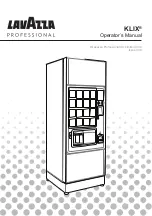
19
RVV Gen II KO Service and Parts Manual
SECTION 3: Vender Programming
Internal (Service)
Menu
Error Codes
If <enter> is pressed at the “Error Codes” prompt, the
controller will enter the error display mode. If no errors
have occurred since the last error reset, the display will
show “None.” If an error has been detected since the last
error reset, the display will show the first summary error
code that has occurred, such as “Vend Mechanism,” which
would indicate a vend error. Pressing <up> or <down>
will allow you to cycle through all of the summary error
codes that are present. Pressing <enter> at the displayed
summary error code will allow you to view the detailed
error codes beneath the summary error heading (see
below). Pressing <up> or <down> at this point will
allow you to cycle through all of the detailed error codes
that are present beneath the summary error code. If the
<exit> button is pressed anytime during this operation, the
controller will return to the “Error Codes” prompt. Press the
<up> button to proceed to the next prompt, “Coin Pay Out.”
If the <clear> button is pressed during the display of any
detailed error code, that error will be cleared. If other
errors exist that fall under the currently accessed detail
type, the next error would be displayed. If no other errors
of the current type exist, the next error summary code
will be displayed, or “None” will be displayed if no other
errors exist.
The error summary codes and their corresponding detailed
error codes are as follows:
•
Control System
By pressing <enter> at the “Control System” prompt,
the controller will display:
1. “Door Switch,” indicating the door switch has
been open for more than an hour;
2. “RAM Checksum,” indicating the machine setup
information has been corrupted;
3. “DC Under Voltage,” indicating that the average
rectified voltage was under 20VDC for more than
30 seconds;
4. “DC Over Voltage,” indicating that the average
rectified voltage was over 45VDC for more than
30 seconds;
5. “System Scale Factor,” indicating one of the
credit peripherals has introduced an incompatible
scaling factor;
6. “Inlet Sense,” indicating the machine’s coin inlet
sensor has been blocked for more than a minute
(note: this is an optional component not installed
on all venders)
; or
7. “Inlet Blocked,” indicating two coins were
sensed at the inlet sensor but didn’t make it to the
changer within 10 seconds.
After taking corrective action to manually fix the
“Control System” errors, the errors may be cleared
electronically via a hand held device or through the
service mode using the <clear> button.
•
Selection Switch
By pressing <enter> at the “Selection Switch” prompt,
the controller will display “Selection Switch XX,”
where “XX” indicates the first selection switch that
has been determined to be closed for more than 15
seconds. If there is a selection key error, navigation of
the service menu will not be possible. This error can
only be cleared by manually correcting or replacing
the keypad.
•
Changer
By pressing <enter> at the “Changer” prompt, the
controller will display either:
1. “Changer Comm,” indicating no changer
communications for more than 2 seconds;
2. “Tube Sense,” indicating a tube sensor error;
3. “Changer Inlet,” indicating no coins sensed by
acceptor for over 96 hours:
4. “Tube Jam XX,” indicating a tube jam error for
coin type XX;
5. “Changer ROM,” indicating a changer ROM
checksum error;
6. “Excessive Escrow” indicating more than 255
escrow attempts since the last coin was accepted;
7. “Coin Jam,” indicating a coin jam;
8. “Low Acceptance,” indicating a low acceptance
rate (more than 20% of the last 255 coins were
slugs);
9. “Disconnected Acceptor,” indicating an
unplugged acceptor; or
10. “Misrouted Coin,” indicating a coin had been
improperly routed.
The “Changer Comm” error will be cleared when
proper communications are re-established. After
taking corrective action to manually fix the other
“Changer” problems, the errors may be cleared
electronically via a hand held device or through the
service mode using the <clear> button.
















































